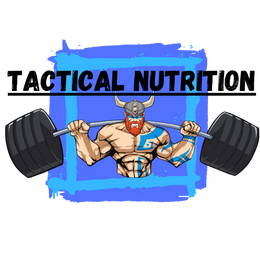Introduction
When it comes to sports supplements, few products have earned the trust and scientific support that creatine monohydrate enjoys. For decades, athletes, lifters, and tactical professionals have used creatine to increase strength, boost power, and accelerate recovery. Unlike many supplements that rely on flashy marketing but lack substance, creatine stands apart as one of the most thoroughly studied and consistently proven supplements in the world of performance.
But what exactly is creatine? How does it work, and why is creatine monohydrate considered the gold standard? This article breaks down the science, clears up common myths, and explains why creatine deserves a place in nearly every athlete’s regimen.
What Is Creatine?
Creatine is a natural compound made from three amino acids—arginine, glycine, and methionine. The body stores creatine primarily in skeletal muscle, where it plays a central role in energy production. About 95% of creatine is found in muscle tissue, and it serves one critical function: helping to regenerate ATP (adenosine triphosphate), the body’s primary energy source for short, explosive movements.
When you sprint, lift a heavy weight, or perform an explosive movement, your muscles rely on ATP for power. Unfortunately, ATP stores run out quickly, often within seconds. Supplementing with creatine increases the amount of stored creatine phosphate in muscles, which helps regenerate ATP faster. This allows athletes and tactical professionals to sustain high-intensity efforts longer and recover more quickly between them.
Why Creatine Monohydrate Is the Gold Standard
Over the years, many different forms of creatine have appeared on the market—creatine hydrochloride, creatine ethyl ester, buffered creatine, and more. While these newer versions often promise superior absorption or reduced side effects, the research consistently shows that creatine monohydrate remains the most effective, affordable, and reliable option.
With over 1,000 published studies confirming its benefits, creatine monohydrate is the only form with decades of long-term safety and performance data behind it. Other versions may sound impressive, but none have been able to outperform the tried-and-true original. For most athletes, there is simply no reason to pay more for unproven alternatives when creatine monohydrate delivers the results.
Benefits of Creatine Monohydrate
One of the biggest reasons creatine has remained popular for decades is its wide range of proven benefits. First and foremost, it consistently increases strength and power. Countless studies show improvements in exercises such as squats, bench presses, sprints, and jumps when creatine supplementation is combined with resistance training.
Creatine also supports muscle growth. By improving performance in the gym and increasing training volume, it indirectly enhances hypertrophy over time. Research also indicates that creatine may reduce muscle cell damage and inflammation, which supports faster recovery and less soreness after hard training sessions.
Endurance athletes and tactical professionals benefit as well. While creatine is best known for short bursts of energy, it also improves the ability to repeat high-intensity efforts. For firefighters climbing stairs in full gear, police officers sprinting during a pursuit, or EMTs carrying patients multiple times per shift, this repeatability is essential.
Perhaps most interesting, emerging research suggests creatine provides cognitive benefits too. Studies show improvements in short-term memory and brain performance, particularly under conditions of sleep deprivation or mental fatigue. For shift workers and first responders, this edge can be just as valuable as the physical boost.
How to Use Creatine Monohydrate
Most athletes benefit from a simple daily dose of 3–5 grams of creatine monohydrate. Some choose to follow a “loading phase,” taking 20 grams per day split into four doses for the first week, followed by the standard 3–5 grams daily. While loading works faster, it is not required. Over time, daily use at the standard dose is just as effective.
Timing is flexible—creatine can be taken before or after workouts, or at any time of day. Many prefer to take it post-workout alongside protein and carbohydrates, but consistency matters more than timing. Creatine mixes easily with water, juice, or protein shakes, and micronized forms tend to dissolve better and reduce stomach discomfort.
Common Myths About Creatine
Despite decades of research, creatine is still surrounded by myths. One common misconception is that creatine is a steroid. This is false. Creatine is not a hormone—it is a natural compound your body already produces and can also obtain from food.
Another myth is that creatine damages the kidneys. Dozens of long-term studies have shown creatine to be safe for healthy individuals, even when taken for years. The only caution applies to people with pre-existing kidney disease, who should consult their physician before use.
Some claim creatine causes bloating. While it does draw water into the muscles, this is intracellular water that supports muscle fullness and performance, not subcutaneous water that leads to a puffy or bloated appearance. Finally, many believe creatine must be cycled, but research shows there is no need. Continuous use is safe, and benefits remain as long as supplementation continues.
Who Should Take Creatine?
The short answer is almost everyone can benefit. Strength athletes such as powerlifters, football players, and wrestlers gain more power and performance. Tactical professionals—firefighters, police officers, EMTs, and military members—gain strength, quicker recovery, and greater resilience under stress. Everyday gym-goers also benefit from improved progress in their training.
Interestingly, older adults may benefit from creatine as well. Studies suggest it helps preserve muscle mass, strength, and even cognitive function with age. For nearly anyone engaged in physical training, creatine offers a safe, effective boost.
Safety and Side Effects
Creatine monohydrate is one of the safest supplements available. The main side effect some users report is mild stomach discomfort, which usually occurs when large doses are taken at once. Splitting doses throughout the day or choosing a micronized form typically eliminates this issue.
Hydration is important when using creatine, since the body stores more water in the muscles. Drinking adequate fluids throughout the day supports both performance and recovery.
Why Tactical Athletes Should Prioritize Creatine
For first responders and military professionals, creatine provides unique advantages. The added strength helps when carrying heavy gear, dragging equipment, or assisting a partner in need. The faster recovery supports long shifts and back-to-back calls. The ability to repeat high-intensity efforts allows responders to stay sharp during unpredictable situations. And the cognitive support under stress or fatigue makes creatine just as valuable for the brain as it is for the body.
Simply put, creatine enhances the exact qualities tactical athletes rely on most: strength, speed, endurance, and resilience.
Conclusion
Creatine monohydrate is not just another supplement—it is the most researched and proven performance enhancer available today. Safe, affordable, and backed by decades of science, it remains the gold standard for athletes and first responders who demand strength, recovery, and peak performance.
Whether you’re a powerlifter chasing a new record, a firefighter climbing multiple flights of stairs in full gear, or an athlete striving to maximize training results, creatine deserves a place in your routine. A consistent dose of 3–5 grams per day is all it takes to unlock one of the most reliable tools in sports nutrition.




